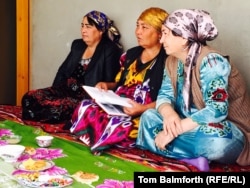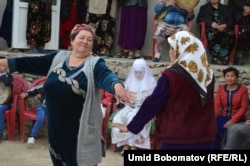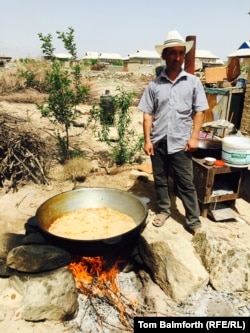KOMOROVO, Tajikistan -- Night was falling across the Ferghana Valley in northern Tajikistan, and when the sun rose again 27-year-old Anvar Aliev was due to be married. Anvar had seen his wife-to-be just twice in his life, and they had never actually spoken.
He and two friends sat on floor cushions, sipping green tea and imagining the first words he would say to her when they are alone. "I have to be on good form. It will depend on what is happening around us of course. It's very important that I hear out everything she has to say."
This was an arranged marriage, and it was the climax of years of work.
Anvar had wanted to have a traditional Muslim wedding, rather than the vodka-soaked marriage ceremonies that were ubiquitous in Soviet Tajikistan.
He had labored for years on construction sites in Russia's oil-rich Tyumen Oblast to build his own house -- pretty much a prerequisite for a groom -- and then to save up for a five-day wedding according to Muslim customs. In the end, however, he would compromise on the latter to avoid problems with the authorities.
Tajikistan's government is wary of a revival of Muslim customs, fearing the rise of radical Islam and worrying about what might happen when young citizens who have gone to Syria to fight alongside Islamic State militants return to Central Asia. (Anvar's name and others in this account have been changed at the family's request to protect their identities, but the family agreed to the use of images.)
My Big Fat Tajik Wedding
Scores of relatives and friends -- the women in long, flowing dresses and head scarves -- have been coming and going, bringing small gifts to his single-story house overlooked by the snowcapped Kurama Mountains. After dark, only the closest stay behind, some already sleeping under the stars on a raised seating platform in the yard.
On the veranda, Anvar's great-aunt -- a little one-eyed woman with a remarkable sprightliness for her eighty-something years -- was singing, clapping, and leading dances with the younger aunts, boasting half-jokingly that no woman was her match at the ceremony.
Through a door, Anvar was sitting at the "dastarkhan," the floor-level dining space, still decked out with the leftovers of a feast: large plates of Uzbek plov, bowls of shurpa soup, lepyoshka loaves, fruit, bowls of sweets, and qatyk, a thick fermented milk drink slurped from the bowl to wash it all down.
Family is the pillar of this clan-based, patriarchal society, and a marriage is no light undertaking.
Throwing a lavish wedding is so important that Tajiks have occasionally been known to bankrupt their families trying, or find themselves saving up money until they were 35 or 40, an unusually old age for marriage.
The government in Dushanbe has responded with wedding regulations. In 2007, Tajikistan limited the number of guests permitted at weddings, capped the number of lambs that can be slaughtered for meals and the number of cars allowed in a wedding cortege, and required the families of the groom and the bride to split overhead costs evenly.
My Own Private Komorovo
Anvar's family had a particularly hard time making the big day happen because his parents had divorced and his father passed away several years ago. Anvar and his mother both worked for years in Russia, 1,500 kilometers from home.
Like many of their neighbors and relatives, they worked in Komorovo, a complex of newly built cottages for the elite near Tyumen, amid the oil fields of western Siberia. Central Asian labor migrants travel in the millions to Russia for work and they like to keep good positions within the clan so they always have a job to go back to if need be.
Anvar and his neighbors used the money they earned in Russia to buy land back home and build houses in a district set apart from the ancestral village of Oshoba, where there was no more room to build. Back in Tajikistan, the neighbors built the same style of cottage they had built in Russia.
In homage and partly in joke, they named their new district Komorovo.
From Crossroads To Backwater
Oshoba is in Tajikistan, but it is entirely ethnic Uzbek, as is Anvar's clan. The village -- or kishlak, as these small settlements are known -- found itself in Soviet Tajikistan after the Bolsheviks redrew the borders in the 1920s.
Before that, Oshoba had been an affluent trade hub on the road through the Kokand Khanate, which united modern Kyrgyzstan, eastern Uzbekistan, Tajikistan, and southeastern Kazakhstan. The khanate became a vassal of the Russian Empire in the late 1860s and was later subsumed into Russian Turkestan.
Oshoba went on become a center of fierce resistance to the Bolsheviks. After the 1917 revolution, Oshoba's residents -- people like Anvar's great-grandfather, a baker by trade -- gained some notoriety in Moscow when they fervently took up arms against the Soviets as part of the Basmachi revolt.
Today, Oshoba itself is a backwater, stranded at Tajikistan's northern tip and hemmed in by borders with Uzbekistan and Kyrgyzstan that cannot be crossed -- except at official checkpoints -- because of animosity between the countries' governments.
Roads here say a lot about politics, corruption, and influence.
In the Soviet Union, it was just a short drive over the mountain from Oshoba to Uzbekistan. Now the stretch of border is mined, and the nearest crossing is over 100 kilometers away.
Leaving Tajikistan Behind
On a long, bumpy drive through the sunbaked valley to pick up an uncle visiting from Uzbekistan, Anvar's uncle Rakhim grumbles, "When a Tajik looks at this road, he thinks how good things were in the Soviet Union."
At one point, the car turns off the cratered road onto a superb stretch of smooth asphalt. But it doesn't last long. The road appears to have been built exclusively to connect the airport to a presidential residence. And, as abruptly as it began, the potholes return as soon as the car passes the driveway to the residence.
Further along, past the regional capital, Khojand -- called Leninabad under the Soviets -- the road improves dramatically: it's Chinese-made and is lined by placards of Tajik President Emomali Rahmon and Chinese President Xi Jinping shaking hands, a sign of China's rising influence in the region.
But for locals looking to make a living, the main destination remains Russia. Unemployment is rife in Tajikistan and many of its citizens spend years working in Russia. An early-spring frost decimated the apricot crop around Oshoba this year, so every young man at the wedding was making the trip.
Some spoke of Russia as an exotic land far from parental eyes where they could have fun. Others saw it as a grim place where they have no choice but to seek work
"I'm 100 percent Tajik through and through -- until the day I change my passport!" a man in the nearby town of Shaydan joked.
Muslim, But Compromised
Anvar wanted to have a Muslim wedding ceremony, which was unusual for his family. He would compromise on this, however, and there was dancing at the ceremony even if it was mainly dry.
The majority of marriages in Central Asia's provinces are arranged, with the parents playing the role of matchmaker. Anvar, however, wanted a practicing Muslim bride and, as his mother didn't know anyone in local mosque-going circles, his Muslim friends helped set up a match his mother subsequently approved.
Muslim weddings primarily differ from the Soviet-style ceremonies in their lack of dancing and in the total absence of alcohol. The lack of booze at Anvar's wedding prompted the odd grumble from some, particularly the older men – many in loose, blue shirts and traditional, tyubeteyka hats -- who occasionally snuck off quietly for some vodka.
The Tajik authorities are much more comfortable with Soviet-style weddings. Fearing radicalization, the government has barred minors from mosques and outlawed head scarves for schoolgirls. Tajik police have sometimes forcibly shaved men's beards, and Rahmon has repeatedly called for the strengthening of secular principles.
The morning of his marriage, Anvar drove in a specially rented, three-car cortege to collect his bride, Nargiz -- in a white wedding dress, her face covered by a veil -- and her family. They drove to register their marriage and exchange rings at the local ZAGS -- the registry office for births, deaths, and marriages that still goes by its Soviet-era acronym. The newlyweds were blessed by a mullah in a ceremony called the "nikakh."
As the bride arrived at Anvar's house, she was welcomed by dozens of wedding guests in the dusty yard, some of whom spontaneously broke out into dance. A woman began to beat a drum rhythmically as a few women danced in front of the other guests seated on chairs.
The newlyweds then led a procession of women indoors and walked to the end of the living room and faced the wall. Here, the women and children followed them in and, as the couple faced the wall of the living room, they built a tall makeshift bed, piling up dozens of ornate floor cushions that had been gifted to the couple in the past days.
Two children and two mothers who had recently been married themselves then clambered onto the bed and pulled a cover over themselves while the couple remained facing the wall.
The two children and mothers huddled there briefly in a little ritual conducted amid giggles, symbolizing a blessing of fertility for the newlyweds. They then got out again, marking the end of the day's formal events -- until the bride's lifting-of-the-veil ceremony the next day.
And it was here later that day that Anvar would speak to his wife for the first time.




